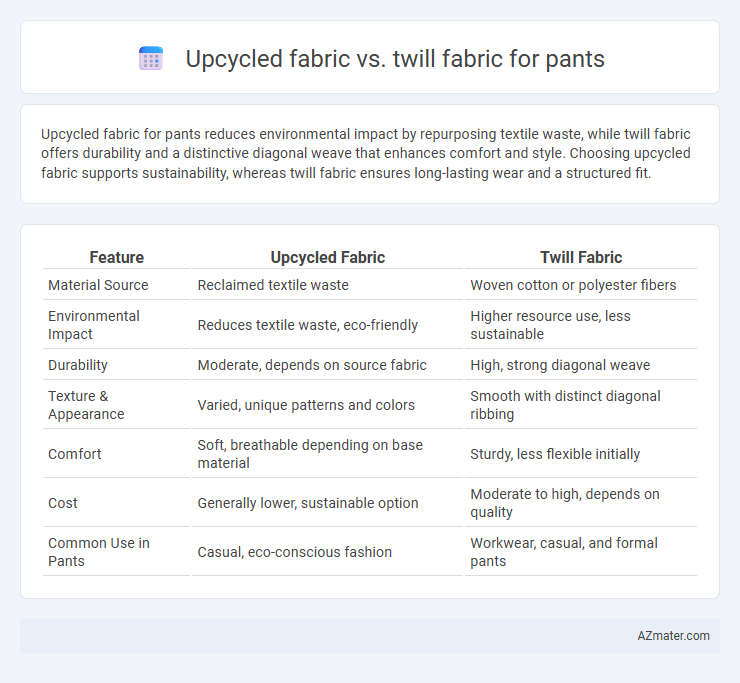Upcycled fabric for pants reduces environmental impact by repurposing textile waste, while twill fabric offers durability and a distinctive diagonal weave that enhances comfort and style. Choosing upcycled fabric supports sustainability, whereas twill fabric ensures long-lasting wear and a structured fit.
Table of Comparison
| Feature | Upcycled Fabric | Twill Fabric |
|---|---|---|
| Material Source | Reclaimed textile waste | Woven cotton or polyester fibers |
| Environmental Impact | Reduces textile waste, eco-friendly | Higher resource use, less sustainable |
| Durability | Moderate, depends on source fabric | High, strong diagonal weave |
| Texture & Appearance | Varied, unique patterns and colors | Smooth with distinct diagonal ribbing |
| Comfort | Soft, breathable depending on base material | Sturdy, less flexible initially |
| Cost | Generally lower, sustainable option | Moderate to high, depends on quality |
| Common Use in Pants | Casual, eco-conscious fashion | Workwear, casual, and formal pants |
Understanding Upcycled Fabric: A Sustainable Choice
Upcycled fabric, created by repurposing existing textile materials, significantly reduces waste and lowers environmental impact compared to traditional fabrics like twill. While twill fabric is known for its durability and distinct diagonal weave ideal for pants, upcycled fabric offers enhanced sustainability by diverting textiles from landfills and minimizing resource consumption. Choosing pants made from upcycled fabric supports eco-friendly fashion initiatives and promotes a circular economy within the apparel industry.
What Is Twill Fabric? Features and Uses
Twill fabric is a textile characterized by its distinct diagonal weave pattern, offering durability, wrinkle resistance, and a smooth surface ideal for pants. Commonly made from cotton or blends, twill fabric provides excellent strength and flexibility, making it popular for jeans, chinos, and workwear. Its ability to resist wear and maintain shape under stress makes twill suitable for everyday and heavy-duty pants applications.
Production Processes: Upcycled vs. Twill Fabric
Upcycled fabric for pants involves repurposing pre-existing textiles, significantly reducing waste and environmental impact by minimizing the need for virgin materials. Twill fabric is woven using a distinct diagonal weave pattern, resulting in durable, tightly structured material commonly produced from new fibers like cotton or polyester. The production process of upcycled fabric centers on sustainability and resource efficiency, whereas twill fabric manufacturing prioritizes strength and fabric texture through controlled weaving techniques.
Environmental Impact of Upcycled and Twill Pants
Upcycled fabric pants significantly reduce textile waste by repurposing discarded materials, leading to lower carbon emissions and water usage compared to conventional twill pants, which rely on newly manufactured fibers. Twill fabric production often involves intensive resource consumption, including water, energy, and chemicals, contributing to environmental degradation and pollution. Choosing upcycled pants supports circular fashion, minimizes landfill waste, and promotes sustainable material use, making it a more eco-friendly option than traditional twill fabric trousers.
Durability and Wear Resistance Comparison
Upcycled fabric for pants offers a unique approach to sustainability but may vary in durability depending on the source materials and treatment processes. Twill fabric, known for its distinctive diagonal weave, provides superior durability and wear resistance, making it ideal for high-stress areas like knees and seat in pants. Twill's tightly woven structure resists abrasions and maintains shape longer compared to many upcycled fabrics, which might show uneven wear based on fiber composition.
Texture, Comfort, and Aesthetic Appeal
Upcycled fabric for pants offers a unique texture with subtle irregularities that enhance the garment's character, while twill fabric provides a smooth, diagonal weave known for durability and a classic look. Comfort in upcycled fabric varies depending on the original material but often incorporates breathable fibers, whereas twill fabric is typically soft yet sturdy, ensuring long-lasting wear. Aesthetic appeal in upcycled fabric leans toward eco-friendly, one-of-a-kind styles with artisanal charm, contrasting with twill's polished, timeless appearance ideal for both casual and formal pants.
Cost Factors: Upcycled vs. Twill Pants
Upcycled fabric for pants often reduces material costs by repurposing pre-existing textiles, making it a budget-friendly and eco-conscious option. Twill fabric, known for its durability and smoother finish, may incur higher production expenses due to sourcing new, high-quality cotton or synthetic fibers. Manufacturers balancing cost factors must consider the long-term sustainability and market demand for upcycled pants versus the traditional appeal and performance of twill trousers.
Versatility in Fashion and Design
Upcycled fabric offers unique patterns and eco-friendly appeal, making it a versatile choice for creating one-of-a-kind pants that emphasize sustainability and creativity. Twill fabric, known for its durable diagonal weave, provides structured comfort and classic style, ideal for versatile wardrobe staples like chinos and workwear. Both materials cater to different fashion needs, with upcycled fabric pushing innovative design boundaries and twill ensuring timeless wearability and ease of tailoring.
Care and Maintenance Requirements
Upcycled fabric pants require gentle care to preserve the integrity of the repurposed materials, often recommending cold water washing and air drying to prevent damage and color fading. Twill fabric pants benefit from durability and can typically endure machine washing on a mild cycle, but care should be taken to avoid high heat drying which may cause shrinkage or weaken fibers. Both fabrics improve longevity with avoiding harsh detergents and ironing on low settings to maintain fabric quality and appearance.
Which Pants to Choose: Upcycled or Twill?
Upcycled fabric pants prioritize sustainability by repurposing existing materials, reducing waste and environmental impact, making them ideal for eco-conscious consumers. Twill fabric pants offer durability and a smooth texture due to their distinctive diagonal weave, providing long-lasting comfort and a polished look suitable for everyday wear. Choosing between upcycled and twill fabric pants depends on whether priority is given to environmental sustainability or fabric strength and traditional style.

Infographic: Upcycled fabric vs Twill fabric for Pants
 azmater.com
azmater.com